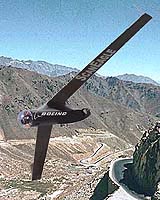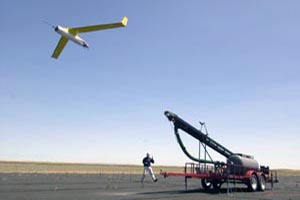Purdue Researchers Participate in Development of ScanEagle UAV
01-12-2006


Professor Jan Vitek's research group, in collaboration with Boeing, participated in the development of the award winning Real-Time Java technology of the ScanEagle unmanned air vehicle (UAV). The ScanEagle's technology received a DUKE's Choice Java Award (or a Dukie Award) at the JavaOne conference general session. In the third year of the Dukies, judges narrowed down worldwide Java application nomination to the top ten of 2005.
The ScanEagle vehicle is used to provide intelligence, surveillance and reconnaissance during exploratory missions. The ScanEagle is a low-cost, long-endurance UAV developed by Boeing and the Insitu Group. A payload board, inserted into the avionics bay and programmed in Real-Time Java, provided autonomous route planning and navigation of the ScanEagle UAV. The technology of ScanEagle allows the vehicle to fly pre-programmed or on operator-initiated missions guided by Global Positioning System and its onboard flight-control system. ScanEagle is four feet long, has a 10-foot wingspan, and can remain in the air for more than 15 hours. ScanEagle is able to fly above 16,000 feet as well as at low altitudes. ScanEagle is lauched autonomously by a pneumatic wedge catapult and retrieved using a "Skyhook" system. The "Skyhook" system uses a hanging rope that the UAV catches. This type of runway-independent lauch/landing allows the ScanEagle to be used any where necessary. Equipped with an electro-optical or an infrared camera, ScanEagle is the first small tactical UAV with an inertially stabilized turret.
Purdue researchers were proud of the ScanEagle performance at the DARPA demonstrations. The UAV delivered real-time streaming imagery to operations personnel and a mission commander on the ground more than 100 miles away. With a simple mouse click, the commander was able to direct the UAV to the next location.
Congratulations to Professor Vitek, David Holmes, Antonio Cunei, Marek Prochazka, Jason Baker, Chapman Flack, and Filip Pizlo for their work on the ScanEagle system.